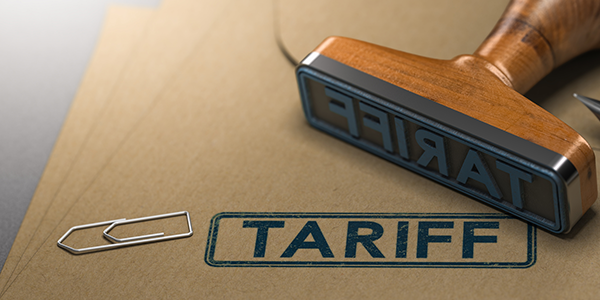
I Asked ChatGPT to Write About Airline Deregulation in the U.S. Here’s How It Went
This year marks the 45th anniversary of deregulation in the domestic commercial airline industry.
If you’re of a certain age, you may remember what flying was like in the years prior. The U.S. government—or, more specifically, the Civil Aeronautics Board (CAB)—was responsible for creating routes and schedules, and it even set airfare. For most American households, flying the friendly skies was prohibitively expensive.
Things have mostly changed for the better post-deregulation. The average price of a round-trip flight in the U.S., adjusted for inflation, has steadily fallen over the years, even if it may not feel like it in nominal terms. This has allowed millions more people to afford the cost of commercial air travel than ever before—and the number continues to grow.
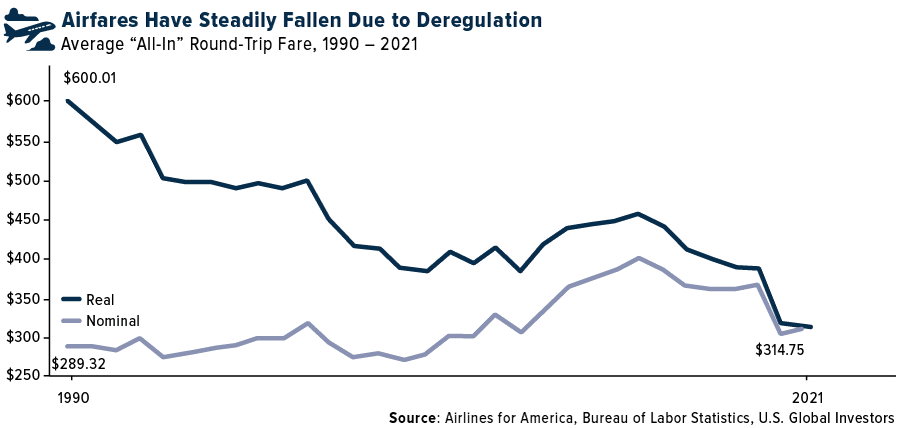
ChatGPT Enters the Chat…
To explore the benefits of airline deregulation further, I sought the help of ChatGPT. Since its launch in November of last year, the open-source content generator, which uses deep learning and artificial intelligence (AI) to mimic natural-sounding human communications, has been a smash hit with just about everyone I’ve discussed it with.
So I decided to put ChatGPT to the test, asking it to write me a blog post on the benefits of domestic airline deregulation. Below are the results, which I have not revised or edited:
Airline deregulation in the United States has had a significant impact on the aviation industry and has greatly benefited consumers. Prior to deregulation in 1978, the Civil Aeronautics Board (CAB) heavily regulated the airline industry, controlling routes, prices, and even the number of flights that could be operated. This resulted in high prices and limited competition.
Deregulation changed all of that. The Airline Deregulation Act of 1978 removed the CAB’s control over routes and prices, allowing airlines to compete freely in the market. This increased competition has led to lower prices for consumers and an increase in the number of flights and destinations offered.
One of the most notable effects of deregulation has been the growth of low-cost carriers, such as Southwest and JetBlue. These airlines have been able to offer lower prices to consumers by operating with lower costs and more efficient business models. This has also led to the creation of new routes and increased accessibility to air travel for many Americans.
In addition, deregulation has also led to the growth of the airline industry as a whole. The number of passengers traveling by air has increased dramatically since 1978, and the industry has become a major contributor to the economy. This has led to the creation of jobs and economic growth in the aviation and tourism sectors.
Deregulation has also led to greater innovation in the industry. Airlines are constantly looking for ways to improve their operations and offer new services to customers. This has led to the development of new technologies, such as e-ticketing and online check-in, which have made air travel more convenient for consumers.
In conclusion, airline deregulation has been a major success in the United States. It has led to increased competition, lower prices, more destinations and flights, greater innovation and overall growth of the industry. The deregulation of the airline industry in 1978 has greatly benefited consumers and the economy, and it continues to do so today.
What are your thoughts? Is ChatGPT destined to replace all content creators?
I’m of two minds. The grammar and punctuation in the passage above are flawless, and the structure makes sense. The facts also check out.
But is it “good” content? I’m not so sure. This might get you an A in an English composition class at the local community college, but it probably wouldn’t be accepted for publication in the New Yorker. Then again, not every piece of writing has to rise to that level to have merit.
Like Bitcoin and crypto in general, AI is still in the very early stages, and I expect to see startling leaps in the quality of human-like thinking and communications in the coming years. This will have huge, as-yet unimagined implications for education, art, science, law and much more.
North American Airlines Generated $39 Billion in Ancillary Fees in 2022
Back to airlines…
One of the biggest consequences of deregulating the airline industry was the creation of new revenue streams to drive profitability and offset volatile fuel costs. These are the ancillary fees I’ve written about so often in the past, and they include everything from seat changes and extra legroom to credit card cobranding and hotel accommodations.
This week, we got an updated snapshot of the global ancillary fee marketplace, as it were. According to CarTrawler and IdeaWorks, the experts on this topic, global airlines raked in an estimated $102.8 billion in 2022, with companies in the U.S. and Canada capturing the largest share of those fees at 38%, or $39 billion. This represents an increase of $15 billion over 2021. Europe claimed the number two spot, seeing $25 billion in ancillary revenues, or about a quarter of the total global amount.
Global Airlines’ Estimated Ancillary Revenue by Region, 2022
Source: CarTrawler, IdeaWorksCompany, U.S. Global Investors
Consumers may bristle at having to pay extra to get an aisle seat, but the fact of the matter is that these non-ticket items are here to stay. They’ve become more and more integral to airlines’ cash flow generation, and since carriers have such a strong moat built around them, passengers have little choice but to pay them. I believe this only enhances the investment case.
European Carriers on a Tear
Recently I shared a chart showing how shares of Asian airlines have jumped on the news that China has relaxed certain Covid-related travel restrictions. They’re not the only ones seeing huge gains.
Take a look at the year-to-date performance of European low-cost carriers (LCCs). Ryanair has increased 29%, Wizz Air 47% and easyJet a phenomenal 60%.
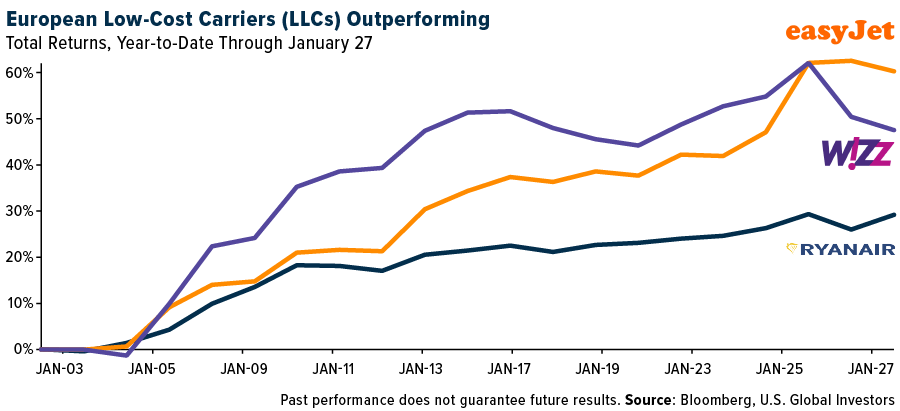
Investors are responding positively to reports that leisure travel demand has returned to pre-pandemic levels. Families are ready to return to the skies after three years, and LLCs are often their preferred choice.

Index Summary
- The major market indices finished up this week. The Dow Jones Industrial Average gained 1.81%. The S&P 500 Stock Index rose 2.46%, while the Nasdaq Composite climbed 4.32%. The Russell 2000 small capitalization index gained 2.36% this week.
- The Hang Seng Composite gained 2.92% this week; while Taiwan was up 0.64% and the KOSPI rose 3.71%.
- The 10-year Treasury bond yield rose 3 basis points to 3.515%.
Airlines and Shipping
Strengths
- The best performing airline stock for the week was EasyJet, up 12.7%. Ryanair took a record number of bookings in January, passing 2 million sales in a weekend for the first time. CEO Michael O’Leary said, “summer looks very strong and fares are rising.” He added that there would be “high single-digit” percentage increases in fares for a second year, the fastest pace he could remember.
- The weekly bottleneck scale at Morgan Stanley dropped from ‘3’ back down to ‘2’ this week as the absolute level of its congestion index declined 18.5% this week. The number of container ships waiting to dock and unload goods along the West Coast remained at zero for the eighth consecutive week, while East Coast backlogs declined to 25 from 36.
- Bombardier pre-announced fourth quarter 2022 with deliveries, sales, and free cash flow ahead of consensus forecasts with a slight beat on adjusted EBITDA. The company also announced a $500 million senior notes offering due 2029, which was upsized to $750 million and priced at 7.5%. Proceeds will pay down $400 million of 2024 debt and $100 million of 2025 debt.
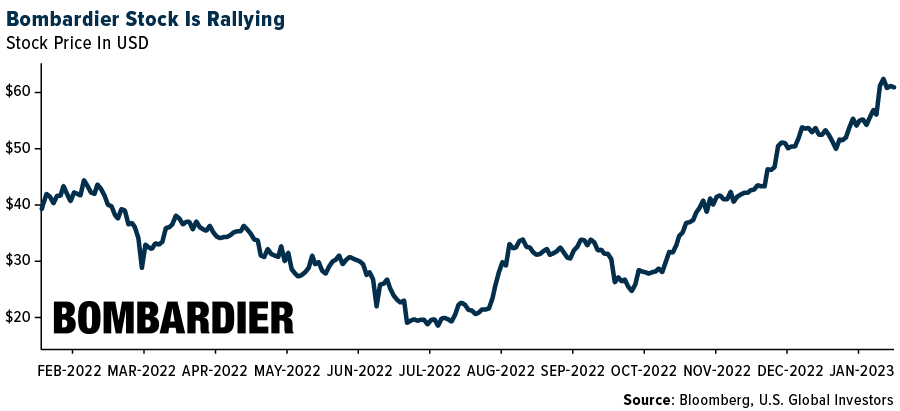
Weaknesses
- The worst performing airline stock for the week was JetBlue, down 6.5%. Bloomberg news reported that pilots in Panama threatened to start a strike on February 2 due to disagreements with Copa on compensation through 2026. If the union and the company do not reach an agreement and there’s a strike, Copa Airlines’ operations may be negatively affected in the first quarter of 2023.
- Maersk and Hapag were both weak on news that Maersk and MSC are to discontinue the 2M alliance in 2025, which prompted fears of a price war and increased capacity. In a joint statement, CEO Vincent Clerc of Maersk, and CEO Soren Toft of MSC said, “MSC and Maersk recognize that much has changed since the two companies signed the 10-year agreement in 2015. Discontinuing the 2M alliance paves the way for both companies to continue to pursue their individual strategies. It was introduced in 2015 by Maersk and MSC with the aim of ensuring competitive and cost-efficient operations on the Asia-Europe, Transatlantic and Transpacific trades.”
- Southwest Airlines reported a December quarter adjusted loss per share of ($0.38), worse than FactSet consensus of ($0.07). The miss versus consensus was driven by higher-than-expected operating expenses. The company had previously estimated the pretax hit from its operational issues in December of $725 million to $825 million, with the final impact coming in at $800 million.
Opportunities
- Virgin Australia owner Bain Capital said it will shortly seek advice on an IPO for the airline. While Bain has made no decisions on when it would seek to float the airline, it importantly noted that it is its intention to retain a significant shareholding in a future IPO of Virgin. This is important as Virgin should remain very rational in terms of both fares and capacity while Bain is a key shareholder, in order to maximize PE firms returns.
- The United States Posta Service is introducing a roughly 4.2% rate hike on First-Class Mail prices to “offset inflation,” along with a price increase for special services such as P.O. Box rental fees and Certified Mail. USPS is not immune to inflationary pressures, but the increase is comfortably below the growth in yields private carriers captured in the upcycle.
- According to Goldman, share prices of Chinese H/A-share airlines and airports rallied by 32%/2% on average from last November following China’s reopening. The next catalyst is more material improvement from end-March, and potential airfare hike (versus 2019).
Threats
- United Airlines expressed doubt that U.S. carriers would be able to achieve their 2023 capacity plans given pilot hiring constraints and recent operational issues. United argued in its recent earnings call that the “Big 4” carriers would deplete the available candidate pool with their hiring needs alone. In addition, United believes that plans to carry less slack in networks and increase asset utilization will not materialize given the challenging operating environment.
- The three big ocean carrier alliances have already planned to cancel 27% of their originally scheduled Asia-Europe sailings during the first seven weeks of the year. Inbound container volumes into the ports of Los Angeles and Long Beach were down 20.2% in December as compared to December 2022. However, questionable demand is the least of the problems for the container shipping segment. In the three years since the beginning of 2020, the container shipping fleet has grown by a combined 11.9%. For 2023 alone, on a gross basis, new deliveries would have the fleet growing by 10.0% and then by 9.9% in 2024.
- Southwest pilots plan to vote on whether to authorize union leaders to call for a strike, reports the Wall St. Journal. The vote is set to start on May 1 prompted by growing frustration among pilots over lack of progress on contract negotiations and the recent winter storm impact in which over 16,700 flights were canceled from December 21 through December 31. The labor negotiations began in March of 2020 before the contract expired in August of 2020.
International Stocks
Strengths
- The best performing country for the week was the Czech Republic, gaining 4.6%. Shares of CEZ, a power generation company, which accounts for about 21% of all assets listed on the Prague Stock Exchange, gained 12.5% in the past five days. Investors expect strong earnings and a higher buyout premium to follow.
- The best performing currency for the week was the Hungarian forint, gaining 1.1%. With a weaker dollar, most emerging market currencies gained, but the Hungarian forint outperformed. Goldman Sachs released a positive report on the currency, predicting it will strengthen along with the brighter outlook for Europe’s economies.
- The Eurozone reported better-than-expected economic data this week. Consumer confidence continues to improve. The preliminary Manufacturing PMI for January increased to 58.8 from 47.8 and the Service PMI unexpectedly crossed above the 50-mark, bringing the Composite PMI to 50.7 from 49.8. Germany’s expectation of economic growth improved as well.
Weaknesses
- The worst performing country for the week was Turkey, losing 4.7%. The Istanbul Stock Exchange has been correcting, year-to-date, due to rising political tensions before presidential elections that are scheduled for May. The country’s central bank keeps defending its currency. A new currency scheme was announced to push exporters to hold less foreign currency. This was done by offering 2% “conversion support” when they exchanged international earnings to the lira.
- The worst performing currency for the week was the Russian ruble, losing 0.9%. The West once again showed its unity against Russia’s aggression in Europe by agreeing to provide much needed tanks, strengthening Ukraine’s future military capabilities.
- Hong Kong reported weaker-than-expected trade balance data this week. In December, Hong Kong’s trade deficit reached 51.6 billion (HKD) versus 27.1 billion (HKD) reported in the prior month. Year-to-date, exports declined more than expected by 28.9% (a 23.4% decline was expected), and imports dropped less than expected by 23.5% (a decline of 25.0% was expected).
Opportunities
- Reuters reported that there has been a notable increase in investors allocating cash to the European equity market and cutting exposure to the United States. Lower natural gas prices with mild winter and softer inflation have improved the economic outlook for Europe. Morgan Stanley’s Investment Management team believes that emerging markets are set to be this decade’s winners.
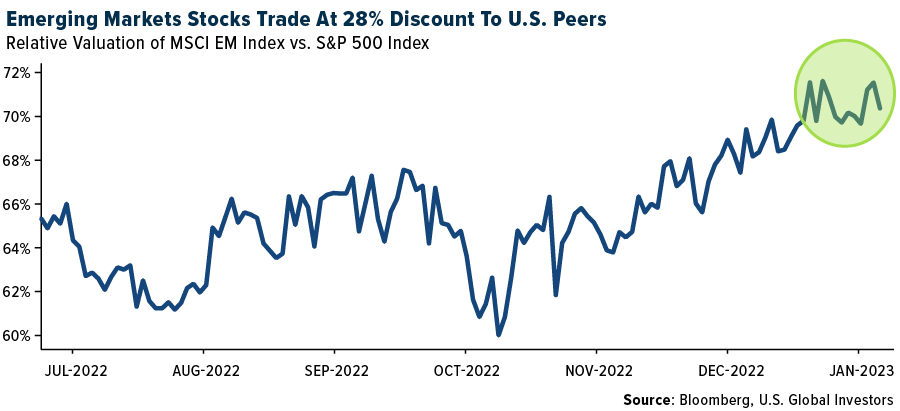
- After months of heavy discussions, this week western countries agreed to send tanks to Ukraine to help the country fight Russian forces and better protect their civilians. This is an important step that may have a significant effect on the outcome of the conflict. Next, the west may approve a transfer of fighter jets. With more military equipment, Ukraine might be able to push the Russian army back to the borders, ending the war and bringing peace to many people (and stock markets).
- Most stock exchanges in the China region had a short week of trading due to Lunar New Year celebrations. Some markets reopened on Wednesday, but others like mainland China and Taiwan, will resume trading on Monday. We expect stronger trading to follow next week, supported by investors’ positive expectations related to further relaxation of Covid restrictions in China after Lunar New Year travel goes back to normal.
Threats
- The United States has confronted Chinese officials with evidence that Chinese State-Owned Enterprises are providing assistance to Russia’s war efforts in Ukraine, according to a Bloomberg report. Sources said shipments include non-lethal military and economic assistance which goes against the sanction that the United States and the West imposed on Russia after the invasion. The U.S. clearly warned China not to help Russia if it wants to avoid confrontations.
- The President of Russia ordered to place an air defense system around Moscow and near Putin’s residency. Pantsir-S1 and S-400 anti-aircraft missile systems have been positioned on the rooftops across the capital and other locations to protect the government’s important buildings and people. On December 5, Ukraine hit an airbase in Russia located 470 miles from the border.
- Many European and Asian equities reported a strong beginning to the year, followed by gains in the last quarter of 2022. Asian stocks gained on growing optimism that China may soon fully open its economy, and European stocks gained after energy prices eased expectations improved for economic growth in the region. We expect a short correction to take place, after a few months of continuous gains.

Energy and Natural Resources
Strengths
- The best performing commodity for the week was lumber, rising 14.67%, which responded positively to the news that U.S. pending home sales rose in December, breaking a consecutive six-month track record of declines in new contracts. Bloomberg reports that economists expected a 1% drop in pending home sales, but they unexpectedly gained 2.5%.
- LG Energy Solution Ltd. of South Korea plans to increase spending by more than 50% to lift global production capacity to 300 gigawatt-hours to meet the rising demand for electric vehicles. Lithium prices have recently fallen back slightly, but Australian producers of spodumene are seeing delays in bringing new lithium mines into production, Canaccord Genuity recently highlighted. Markets could remain tight.
- Bank of America’s thirteenth bi-annual survey of U.S. agriculture retailers in collaboration with Purdue University suggests that 2023 will be another good year for the farm economy. In fact, 43% of survey respondents believe farm incomes will be flat-to-higher in the 2023/2024 marketing year despite very tough comps. The bank’s own analysis suggests that profitability will decline versus last year but remain at near-record levels.
Weaknesses
- The worst performing commodity for the week was crude oil, dropping 2.76%. Natural gas equities have underperformed the broader energy sub-sectors due to lower gas prices driven largely from rising supply, lower weather-driven local demand, and start-up delays at the Freeport LNG export terminal.
- Copper prices ended a five-week string of consecutive gains on the China reopening trade. Reduced supplies from Peru also played a factor in its price strength. Bloomberg cites profit taking to close out the week before Chinese markets report next week post the Lunar New Year holiday.
- Fastmarkets RISI published containerboard pricing, with kraft liner down $10 per ton this month. Domestic kraft liner prices are down $50 per ton since November 2022. Recycled grades declined $20 per ton this month. Overall, “70% of buyers and sellers reported linerboard price declines of $30 per ton to $100 per ton,” according to P&PW.
Opportunities
- JPMorgan is raising its estimate for China’s oil demand growth to 770,000 barrels per day on the back of higher demand for gasoline, diesel, jet fuel and asphalt, somewhat tapered by a drag from weaker demand for export-oriented petrochemical products. China’s demand remains on track to expand to nearly 16 million barrels per day this year—a record high—and is set to account for nearly 40% of the 1.8 million barrels per day global demand growth the group is forecasting in 2023.
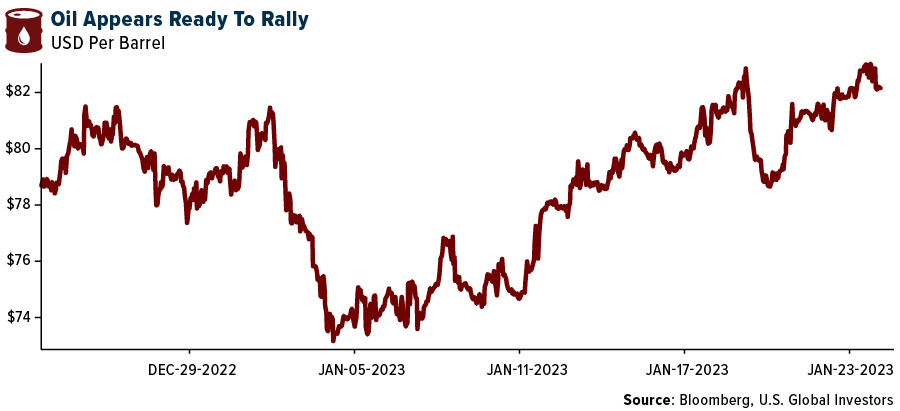
- Bank of America believes Big Oil’s redemption roadmap will keep unfolding for those finding the following three signposts: 1) Continued capex discipline (below average 7% year-over-year growth in Big Oil budgets); 2) instead favoring shareholder distributions (they see average CFFO payouts climb from 25% last year to 33% this year); 3) underestimated cash flow resilience form above-average Downstream>Upstream exposure, rare organic volume growth, working capital inflows and per share support from above-average buybacks.
- Bank of America also sees two dynamics supporting continued outperformance of U.S. refiners. Near term, tailwinds from one of the strongest seasonal set ups for refining margins heading into elevated maintenance season. Longer term, the bank continues to believe price discovery of a new mid cycle for refining margins is still playing out with current indicators significantly above its current assumptions for a new ‘regional’ golden age of refining.
Threats
- Rystad Energy believes U.S. natural gas prices could drop to $2 in the next few months with rising domestic supplies exceeding demand, as reported by Bloomberg. Rystad noted the mild winter, rising production this year, and the bottlenecking of domestic gas exports hindered by the Freeport LNG terminal being out of commission since June do to a fire at the facilities. Natural gas has certainly been weak as of late, but it could get worse.
- Protests in Peru are threatening to choke off access to almost $4 billion worth of copper just as China’s emergence from Covid lockdowns promises to boost demand. Peru’s third-largest copper mine, Las Bambas, hasn’t dispatched copper concentrate since January 3 due to security concerns. Glencore Plc’s Antapaccay is also facing restrictions. The mines, which share the same highway access to ports, together account for nearly 2% of the world’s copper output.
- The International Food Policy Research Institute issued a warning on food supply dynamics they expect to unfold this year. After last year’s rampant run in food prices, fertilizer prices and diesel fuel remain elevated, particularly the later continuing to squeeze profit margins for farming operations. Grain stockpiles around the world are tight but with low profitability farmers have reduced resources to boost production.
Blockchain and Digital Currencies
Strengths
- Of the cryptocurrencies tracked by CoinMarketCap, the best performer for the week was Threshold, rising 115.40%.
- Philip Hammond, the United Kingdom’s former chancellor, was appointed chairman of crypto custodian Copper Technologies. Hammond, who had been a senior adviser to the London-based firm since 2021, starts the role with immediate effect, writes Bloomberg.
- Moody’s Corp. is working on a scoring system for stablecoins, the crypto sector’s most traded tokens, as the asset class grows and faces increased scrutiny from regulators and investors. The system will include an analysis of up to 20 stablecoins based on the quality of attestations on the reserves backing them, writes Bloomberg.
Weaknesses
- Of the cryptocurrencies tracked by CoinMarketCap, the worst performing for the week was Casper, down 4.41%.
- Genesis’s chapter 11 filing last week showed that it owes its top 50 creditors more than $3 billion. The VanEck New Finance Income fund is among the top 10 known largest with a claim of $53 million, writes Bloomberg.
- BlackRock and Apollo Global Management are among a group of creditors that lent around $500 million to bankrupt Bitcoin miner Core Scientific by purchasing convertible notes. The disclosures reveal how traditional finance firms helped to bankroll the crypto-mining industry firms, reports Bloomberg, but a plunge in price of Bitcoin has slashed the profit margins of miners threatening the companies with insolvency.
Opportunities
- Donald Trump NFT sales are up 158% following the news that Meta restored his Facebook and Instagram accounts. According to OpenSea, the sales of Trump digital trading cards reached 312 and volume reached 109 Ethereum, writes Bloomberg.
- Bitcoin has had an incredible start to the year; the cryptocurrency has been up, at one point 40%, for the month of January.
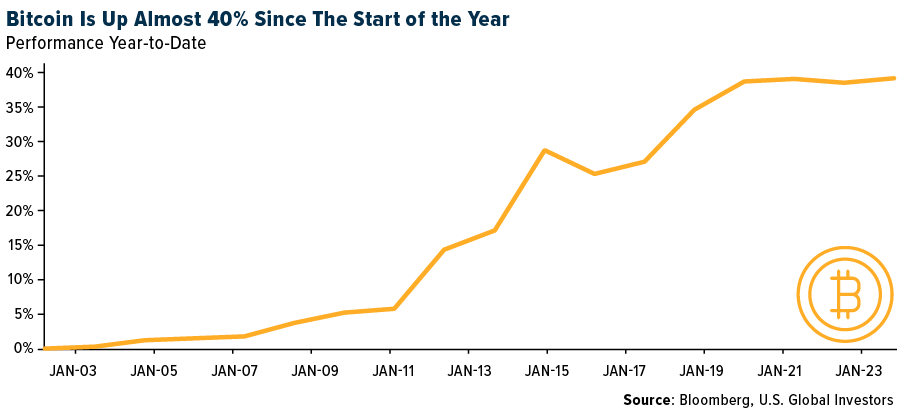
- The Floki Inu price soared 14% following a DAP proposal to burn $55 million in tokens. The governance proposal would see 4.97 trillion floki token burnt, worth around $55 million, writes Bloomberg.
Threats
- Binance Holdings acknowledged that it mistakenly keeps collateral for some of the tokens it issues in the same wallet as exchange-customer funds. Reserves for almost half of the 94 coins that Binance issues are currently stored in a single wallet called “Binance 8” which also holds customer assets, Bloomberg explains. That wallet contains significantly more tokens in reserve than would be required for the number of B-tokens that Binance has issued, indicating that collateral is being mixed with customers’ coins rather than being stored separately.
- Not long before FTX collapsed in November, its founder Sam Bankman-Fried sent $400 million to an obscure cryptocurrency trading firm called Modulo Capital. The fledgling firm which was founded in March and operated out of the same Bahamian compound where SBF lived, had no track record of public profile according to an article published by Bloomberg.
- The Dutch Central Bank fined crypto exchange Coinbase for providing digital-asset services in the country prior to its local registration in September. The central bank said it’s imposing an admirative fine of $3.63 million for operating in the country without registration writes Bloomberg.
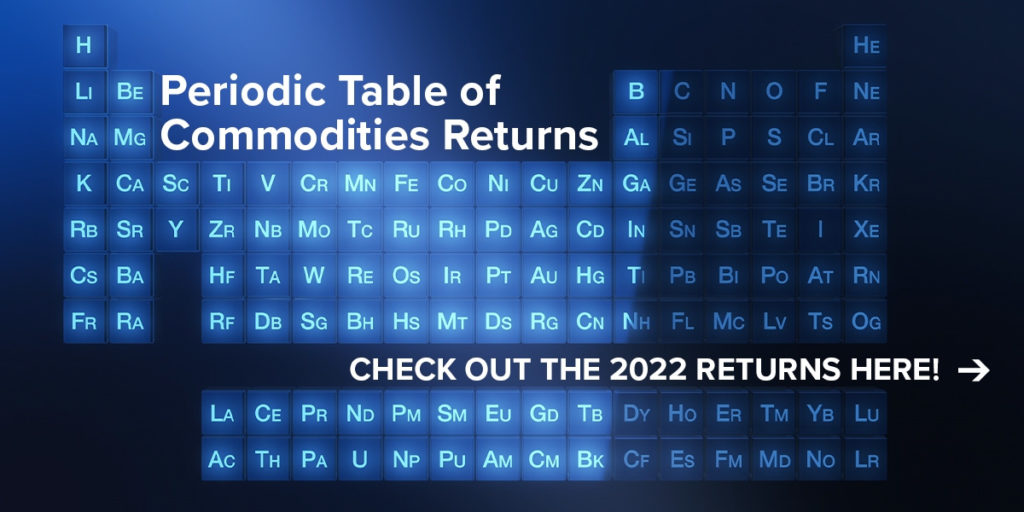
Gold Market
This week gold futures closed at $1,944.40, down $0.50 per ounce, or 0.03%. Gold stocks, as measured by the NYSE Arca Gold Miners Index, ended the week higher by 0.15%. The S&P/TSX Venture Index came in off 0.29%. The U.S. Trade-Weighted Dollar fell 0.07%.
Strengths
- The best performing precious metal for the week was gold, but still down 0.03%. The Personal Consumption Expenditure (PCE) core price index eased further in December, perhaps laying the groundwork for the Federal Reserve to continue to ease up on rates. Consumer spending also fell over the coinciding period.
- Endeavour Mining pre-released fourth-quarter gold production of 355,000 ounces, a beat versus consensus of 337,000 ounces, as reported by Reuters. Fourth-quarter all-in sustaining cost (AISC) was $954 per ounce, a beat versus $962 per ounce consensus. 2022 full-year production was 1.4 million ounces versus guidance of between 1.3 and 1.4 million ounces.
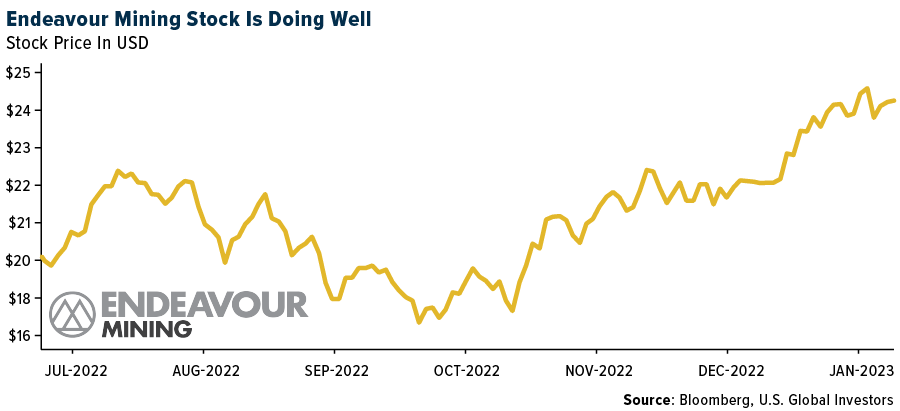
- Shares of Star Royalties rose 18% this week on record preliminary fourth-quarter revenue growth of 30%, a positive considering 2022 is the company’s first year of operation. A more open investment environment for consolidation is in motion with the gold market firming up to some extent in the royalty space with Triple Flag Precious Metals completing its acquisition of Maverix Metals.
Weaknesses
- The worst-performing precious metal for the week was palladium, falling 6.71% on no specific headline; however, all the headlines about increasing electric vehicle (EV) battery plants across the U.S. have negative implications for future palladium demand. UBS estimates that South Africa’s 2022 primary production of 12.8 million ounces of platinum group metals (PGM) was one of the worst on record in the past two decades, surpassed only in 2020 (Covid disruptions) and 2014 (prolonged strike impact). To put this in perspective, primary PGM supply in 2022 was around 1.1 million ounces below the 20-year average and 3.2 million ounces below the 16-million-ounce peak produced in 2007.
- According to RBC, Evolution Mining’s second-quarter operational performance was slightly weak overall, following a soft first quarter. Persistent issues at Red Lake and rain at Mount Rawdon saw the December quarter’s 166,000-ounce missing consensus by 6%. However, Cowal did well on better throughput and rising grade.
- St. Barbara announced this week that in the December quarter of 2022, its total production was 60,976 ounces of gold, reports Kitco News, down 7% year-on-year and down 4% compared to the previous quarter. The company said that the increased ore mined at Gwalia was offset by delays accessing high-grade stopes to next quarter, resulting in lower-grade development ore being processed.
Opportunities
- West African Resources reported meeting its gold guidance this week, as growth gets going, according to MiningNews.net. The company produced around 50,000 ounces at AISC of US$1,286 per ounce in the December quarter, taking full-year production to 229,224 ounces at ASIC of $1,086 per ounce. The market was unimpressed, selling the shares off nearly 13% locally in Australia.
- Equinox Gold has provided a construction update at its 60% owned Greenstone Project in Ontario. As of January 13, 2023, the company says the project is now 66% complete and is on schedule to pour gold in the first half of 2024. On December 31, 2022, 71% of total capital costs had been contracted and $680M (55%) of the $1.23 billion construction budget had been spent (100% basis), meaning the company’s share of the remaining budget is $330 million.
- Dundee Precious Metals shares have performed well year-to-date, up 40% in the first month of 2023. However, after the release of the Ada Tepe updated technical report and announcement of the high-grade deposit at the Čoka Rakita prospect in Serbia, key catalysts are now priced in. The Ada Tepe asset has a short mine life remaining, and any exploration upside from the Čoka Rakita prospect is expected to be long-dated, with additional work on the Timok feasibility study paused to focus on further exploration.
Threats
- Ramelius Resources released the Edna May Stage 3 Cutback pre-feasibility study (PFS) and made the rejection of the project official. Last year’s strategy outlook did not include the open pit extension after it was included in 2021. This suggested the company was already planning for Edna May life without the cutback. The 2022 strategy update likely finalized its removal from most market expectations, dampening the effect of this week’s announcement.
- First Majestic’s fourth-quarter production of 2.4 million ounces of silver and 63,000 ounces of gold is driven by higher gold production at Jerritt Canyon. Fiscal year 2023 cash cost and AISC are guided at $13.88-$14.66 per ounce. The fourth-quarter 2022 operational results and fiscal year 2023 guidance appear as a negative for First Majestic shares as the fourth quarter fell short of consensus production estimates due to lower-than-modeled grade and throughput (and fiscal year 2023 cash costs and AISC were guided higher than consensus).
- Continued blackouts in South Africa threaten the industry’s viability to operate. Bloomberg reports power outages last year lowered production, and the days of power cuts in each month continued to increase in magnitude, reaching 30 days in December. South Africa mines about 70% of the world’s platinum and 40% of all palladium production.


U.S. Global Investors, Inc. is an investment adviser registered with the Securities and Exchange Commission (“SEC”). This does not mean that we are sponsored, recommended, or approved by the SEC, or that our abilities or qualifications in any respect have been passed upon by the SEC or any officer of the SEC.
This commentary should not be considered a solicitation or offering of any investment product. Certain materials in this commentary may contain dated information. The information provided was current at the time of publication. Some links above may be directed to third-party websites. U.S. Global Investors does not endorse all information supplied by these websites and is not responsible for their content. All opinions expressed and data provided are subject to change without notice. Some of these opinions may not be appropriate to every investor.
Holdings may change daily. Holdings are reported as of the most recent quarter-end. The following securities mentioned in the article were held by one or more accounts managed by U.S. Global Investors as of (12/30/22):
Perseus Mining
Dundee Precious Metals
Ramelius Resources
Bombardier
Ryanair Holdings
Maersk
Copa Holdings
Southwest Airlines
United Airlines
Wizz Air Holdings Plc
easyJet PLC
JetBlue Airways Corp.
*The above-mentioned indices are not total returns. These returns reflect simple appreciation only and do not reflect dividend reinvestment.
The Dow Jones Industrial Average is a price-weighted average of 30 blue chip stocks that are generally leaders in their industry. The S&P 500 Stock Index is a widely recognized capitalization-weighted index of 500 common stock prices in U.S. companies. The Nasdaq Composite Index is a capitalization-weighted index of all Nasdaq National Market and SmallCap stocks. The Russell 2000 Index® is a U.S. equity index measuring the performance of the 2,000 smallest companies in the Russell 3000®, a widely recognized small-cap index.
The Hang Seng Composite Index is a market capitalization-weighted index that comprises the top 200 companies listed on Stock Exchange of Hong Kong, based on average market cap for the 12 months. The Taiwan Stock Exchange Index is a capitalization-weighted index of all listed common shares traded on the Taiwan Stock Exchange. The Korea Stock Price Index is a capitalization-weighted index of all common shares and preferred shares on the Korean Stock Exchanges.
The Philadelphia Stock Exchange Gold and Silver Index (XAU) is a capitalization-weighted index that includes the leading companies involved in the mining of gold and silver. The U.S. Trade Weighted Dollar Index provides a general indication of the international value of the U.S. dollar. The S&P/TSX Canadian Gold Capped Sector Index is a modified capitalization-weighted index, whose equity weights are capped 25 percent and index constituents are derived from a subset stock pool of S&P/TSX Composite Index stocks. The NYSE Arca Gold Miners Index is a modified market capitalization weighted index comprised of publicly traded companies involved primarily in the mining for gold and silver. The S&P/TSX Venture Composite Index is a broad market indicator for the Canadian venture capital market. The index is market capitalization weighted and, at its inception, included 531 companies. A quarterly revision process is used to remove companies that comprise less than 0.05% of the weight of the index, and add companies whose weight, when included, will be greater than 0.05% of the index.
The S&P 500 Energy Index is a capitalization-weighted index that tracks the companies in the energy sector as a subset of the S&P 500. The S&P 500 Materials Index is a capitalization-weighted index that tracks the companies in the material sector as a subset of the S&P 500. The S&P 500 Financials Index is a capitalization-weighted index. The index was developed with a base level of 10 for the 1941-43 base period. The S&P 500 Industrials Index is a Materials Index is a capitalization-weighted index that tracks the companies in the industrial sector as a subset of the S&P 500. The S&P 500 Consumer Discretionary Index is a capitalization-weighted index that tracks the companies in the consumer discretionary sector as a subset of the S&P 500. The S&P 500 Information Technology Index is a capitalization-weighted index that tracks the companies in the information technology sector as a subset of the S&P 500. The S&P 500 Consumer Staples Index is a Materials Index is a capitalization-weighted index that tracks the companies in the consumer staples sector as a subset of the S&P 500. The S&P 500 Utilities Index is a capitalization-weighted index that tracks the companies in the utilities sector as a subset of the S&P 500. The S&P 500 Healthcare Index is a capitalization-weighted index that tracks the companies in the healthcare sector as a subset of the S&P 500. The S&P 500 Telecom Index is a Materials Index is a capitalization-weighted index that tracks the companies in the telecom sector as a subset of the S&P 500.
The Consumer Price Index (CPI) is one of the most widely recognized price measures for tracking the price of a market basket of goods and services purchased by individuals. The weights of components are based on consumer spending patterns. The Purchasing Manager’s Index is an indicator of the economic health of the manufacturing sector. The PMI index is based on five major indicators: new orders, inventory levels, production, supplier deliveries and the employment environment. Gross domestic product (GDP) is the monetary value of all the finished goods and services produced within a country’s borders in a specific time period, though GDP is usually calculated on an annual basis. It includes all private and public consumption, government outlays, investments and exports less imports that occur within a defined territory.
The S&P Global Luxury Index is comprised of 80 of the largest publicly traded companies engaged in the production or distribution of luxury goods or the provision of luxury services that meet specific investibility requirements.
The S&P Global Luxury Index is comprised of 80 of the largest publicly traded companies engaged in the production or distribution of luxury goods or the provision of luxury services that meet specific investibility requirements.
The MSCI Emerging Markets Index captures large and mid-cap representation across 24 Emerging Markets (EM) countries.












